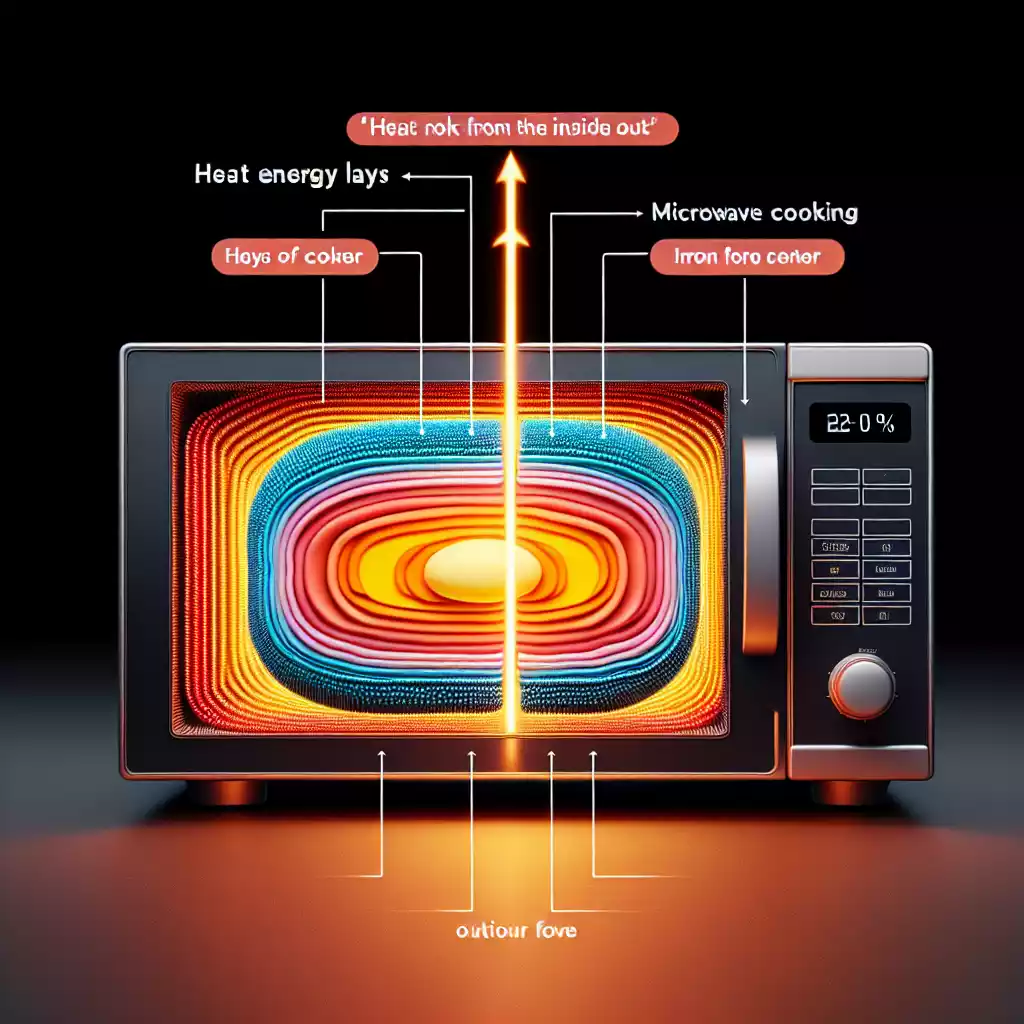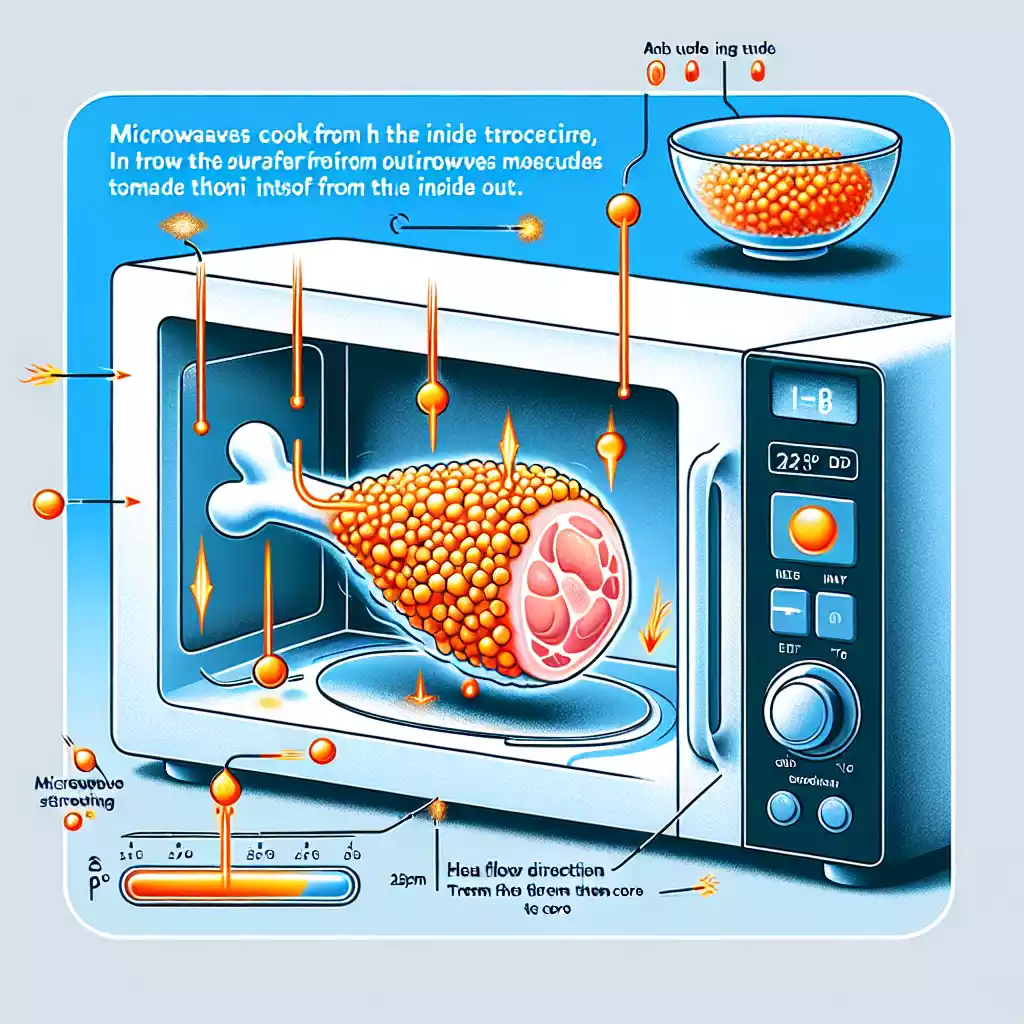Understanding Microwave Cooking
Microwave ovens have become a staple in modern kitchens, but there is still some confusion about how they actually cook food. The common belief is that microwaves cook food from the inside out. Is this true, or just a myth? To answer this question, we need to delve into the science behind microwave cooking.
How Microwaves Work
Microwave ovens use electromagnetic waves to heat food. These waves are generated by a component called a magnetron. The waves penetrate the food and cause water molecules within to vibrate rapidly. This vibration creates heat, which cooks the food.
The Science Behind Microwave Cooking
The waves in a microwave oven typically penetrate food to a depth of about one inch. Beyond this depth, the heat is transferred by conduction, just like in conventional cooking methods. This means the outer layers of the food heat up first, and the heat then moves inward.
Microwave Penetration Depth
Factors Affecting Penetration Depth
Several factors can influence how deeply microwaves penetrate food. These include the food’s water content, density, and shape. Foods with high water content, like vegetables, heat more quickly and evenly than denser foods like meat.
Comparison with Conventional Cooking Methods
In traditional cooking methods, heat is applied from the outside, and it moves inward through conduction. Microwaves, on the other hand, heat the outer layers first, and the heat then spreads inward. This is why thicker foods might not cook evenly in a microwave.
Common Misconceptions About Microwaves

The Myth of Inside-Out Cooking
The idea that microwaves cook food from the inside out is a misconception. As we’ve discussed, microwaves heat the outer layers first, and the heat then moves inward. This can sometimes give the illusion that the food is cooking from the inside out, especially with certain foods.
Why Foods Heat Unevenly
Microwaves can heat food unevenly due to several factors, including the shape and size of the food, the placement in the microwave, and the power level used. Using a microwave-safe turntable can help distribute heat more evenly.
Microwave-Safe Containers
Choosing the Right Container
Using the right container is crucial for safe and effective microwave cooking. Glass, ceramic, and certain plastics labeled “microwave-safe” are ideal. Metal containers should be avoided as they can cause sparks and fires.
Materials to Avoid
Avoid using containers that are not labeled as microwave-safe. These can release harmful chemicals into your food or cause the container to melt. Always check the label before using any container in the microwave.
Cooking Techniques for Even Heating
Stirring and Rotating Food
To ensure even heating, it’s a good idea to stir or rotate your food halfway through the cooking process. This helps distribute the heat more evenly and prevents hot spots.
Using Microwave Accessories
Microwave-safe accessories, such as turntables and covers, can help improve the cooking process. Turntables ensure that the food rotates while cooking, and covers help retain moisture and heat.
Nutritional Impact of Microwave Cooking
Retention of Nutrients
Microwave cooking can actually help retain more nutrients compared to other cooking methods. The shorter cooking times and reduced exposure to heat help preserve vitamins and minerals.
Comparison with Other Cooking Methods
Compared to boiling or frying, microwaving can be a healthier option. Boiling can leach nutrients into the water, and frying adds extra fat. Microwaving, on the other hand, uses less water and no added fat, making it a healthier choice.
Safety Considerations
Preventing Burns and Hot Spots
Microwave cooking can sometimes result in uneven heating, leading to hot spots that can cause burns. Always let food stand for a minute or two after cooking to allow the heat to distribute evenly.
Avoiding Microwave Hazards
Never use metal containers or aluminum foil in the microwave. These can cause sparks and fires. Also, be cautious with plastic containers, as some can release harmful chemicals when heated.
Historical Perspective
Evolution of Microwave Technology
Microwave ovens have come a long way since their invention in the 1940s. Initially used for military purposes, they eventually became a household appliance in the 1960s and 70s.
Adoption in Modern Kitchens
Today, microwaves are an essential part of most kitchens. They offer a quick and convenient way to cook and reheat food, making them invaluable for busy households.
Microwave Cooking Tips
Maximizing Efficiency
To get the most out of your microwave, use it for tasks it excels at, like reheating leftovers, steaming vegetables, and defrosting frozen foods. This will save you time and energy.
Common Mistakes to Avoid
Avoid common mistakes like overcooking, using the wrong containers, and not covering food. These can lead to uneven heating, loss of nutrients, and even safety hazards.
Popular Microwave Recipes
Quick and Easy Meals
Microwaves are perfect for quick and easy meals. Some popular options include microwave mug cakes, scrambled eggs, and steamed vegetables. These can be prepared in just a few minutes.
Healthy Microwave Options
For those looking to eat healthier, microwaves can be used to steam vegetables, cook oatmeal, and even make healthy snacks like popcorn. These options are quick, easy, and nutritious.
Microwave Maintenance and Care
Cleaning and Maintenance Tips
Keeping your microwave clean is essential for both hygiene and performance. Wipe down the interior after each use, and deep clean it regularly with a mixture of vinegar and water.
Extending the Lifespan of Your Microwave
Regular maintenance, such as checking the door seal and ensuring the turntable is functioning properly, can help extend the lifespan of your microwave. This will save you money in the long run.
Environmental Impact of Microwave Use
Energy Consumption
Microwaves are generally more energy-efficient than conventional ovens, especially for small tasks like reheating food. This can help reduce your household’s energy consumption.
Comparing Environmental Footprints
When compared to other cooking methods, microwaves have a smaller environmental footprint. They use less energy and produce fewer emissions, making them a more sustainable choice.
Innovations in Microwave Technology
Smart Microwaves
The latest innovation in microwave technology includes smart microwaves that can be controlled via smartphone apps. These offer features like voice control, recipe suggestions, and automatic cooking settings.
Advanced Features and Functions
Modern microwaves come with a range of advanced features, including sensor cooking, convection options, and even grilling capabilities. These features make microwaves more versatile than ever.
Frequently Asked Questions
FAQ 1: How do microwaves heat food?
Microwaves use electromagnetic waves to cause water molecules in food to vibrate, creating heat that cooks the food.
FAQ 2: Is microwave cooking safe for health?
Yes, microwave cooking is safe when used correctly. It can even retain more nutrients compared to other cooking methods.
FAQ 3: Why does food sometimes cook unevenly in a microwave?
Food can cook unevenly due to factors like shape, size, and placement in the microwave. Using a turntable and stirring can help distribute heat more evenly.
FAQ 4: Can I use any container in a microwave?
No, only use containers labeled as microwave-safe. Avoid metal and certain plastics that can release harmful chemicals.
FAQ 5: What are the best practices for microwave cooking?
Best practices include using microwave-safe containers, covering food to retain moisture, stirring or rotating food, and following the manufacturer’s instructions.
Conclusion
Microwave ovens are a versatile and convenient tool in modern kitchens. They use electromagnetic waves to heat the outer layers of food, with the heat then moving inward. Understanding how microwaves work can help you use them more effectively and safely. Whether you’re reheating leftovers, cooking a quick meal, or even steaming vegetables, microwaves offer a range of benefits. Always use microwave-safe containers, follow best practices, and enjoy the convenience and efficiency that microwave cooking provides.

